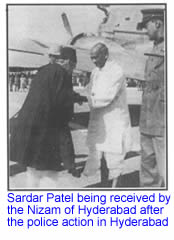
Dimdima
Online Children's Magazine from India

Dimdima
Online Children's Magazine from India
At the time of Independence, two-fifths of the Indian subcontinent was under the direct rule of rajas and nawabs. These rulers had acknowledged British paramountcy and had been given almost a free hand in ruling their states.
Out of the 562 princely states, only 14 were in or adjacent to Pakistan and the rest were all in India.
The people of the princely states had not remained unaffected by the freedom struggle in British India. They acknowledged the leadership of Gandhiji, Jawaharlal Nehru, Vallabhbhai Patel, Subhas Chandra Bose and others. They had organised anti-British demonstrations during the 'Quit India' movement. When the British left India it was clear that the people of the princely states wanted to become one with the people of the former British India, now a
democracy.
 While
most of the princes were reconciled to losing their hereditary power, there were some who cherished ambitions of becoming monarchs of sovereign states. But Sardar Patel who was the Minister of Home had no intention of allowing any other sovereign state to emerge on the Indian sub-continent. Ably assisted by V.P. Menon he could persuade all the princes except three to sign the Instrument of Accession, allowing the Government of India to handle Defence,
Foreign Affairs and Communications. This he achieved by August 14, 1947. Long drawn-out negotiations followed to bring about total integration of these states with India.
While
most of the princes were reconciled to losing their hereditary power, there were some who cherished ambitions of becoming monarchs of sovereign states. But Sardar Patel who was the Minister of Home had no intention of allowing any other sovereign state to emerge on the Indian sub-continent. Ably assisted by V.P. Menon he could persuade all the princes except three to sign the Instrument of Accession, allowing the Government of India to handle Defence,
Foreign Affairs and Communications. This he achieved by August 14, 1947. Long drawn-out negotiations followed to bring about total integration of these states with India.
The Nawab of Junagadh wanted to join Pakistan but he did not have the support of his people. They rose in rebellion and the nawab fled. In a referendum held soon after, the people voted for accession of their state with India.
The Nizam of Hyderabad had no wish to sign the Instrument of Accession though his subjects were clearly in favour of joining India. He signed a stand-still agreement with the Government of India in November, 1947 which gave him a
year's time to make up his mind. But when he showed no inclination to sign the Instrument of Accession and tried to gather international support for his stand on Hyderabad and let loose the Razakar goons on his people, Sardar Patel
thought enough was enough and sent the army in.
The army met with hardly any resistance and was welcomed with open arms by the populace.
The ruler of Kashmir was Hindu and the majority of the population was Muslim but the state remained unaffected by the communal tension in the rest of the sub-continent. While Maharaja Hari Singh was pondering over the choices before him, raiders from across the Pakistan border intruded into Kashmir. The ruler asked India for military help but India sent its army only after the maharaja had signed the Instrument of Accession.
The Indian army halted the advance of the raiders. However, the territory already occupied by the raiders with Pakistan's connivance, still remains in Pakistani hands.
The Constituent Assembly headed by Dr. Rajendra Prasad and with Dr. B.R. Ambedkar as Chairman of the Drafting Committee, drew up a constitution for free India. It was under this constitution that India became a sovereign democratic Republic on 26th January 1950 (26th January had been called Independence Day from 1930 after Jawaharlal Nehru had declared Purna Swaraj as the goal of the people of India in 1929). Under the Constitution, Dr. Rajendra Prasad was sworn in as the first president of the Republic of India.
Sadly, even by 1950, there were parts of India that were still under European rule. Chandranagore, Yanam, Karaikal, Pondicherry and Mahe were under French occupation. Goa, Daman, Dadra Nagar Haveli and Diu were ruled by the Portuguese.
The French handed over their Indian territories to India in 1954. The Portuguese however, stubbornly refused to quit Goa despite opposition to their rule by Goan nationalists like Purshottam Kakodkar, Tristao da Braganza Cunha, Mohan Ranade and Telo Mascarenhas. They were finally ousted in December 1961 when the Indian army moved simultaneously into the three territories. There were about 3000 Portuguese soldiers in Goa at that time and the Portuguese Governor-General, realising that resistance was futile ordered his men to lay down their arms.
The Portuguese were the first to come and the last to go. However, the India which the Portuguese vacated in 1961 was vastly different from the India Vasco da Gama had set foot on in 1498. Then, a conglomeration of princely states, it was now one large united country - the largest democracy in the world.
Dimdima is the Sanskrit word for ‘drumbeat’. In olden days, victory in battle was heralded by the beat of drums or any important news to be conveyed to the people used to be accompanied with drumbeats.
Bharatiya Vidya Bhavan
K. M Munshi Marg,
Chowpatty, Mumbai - 400 007
email : editor@dimdima.com
Bharatiya Vidya Bhavan
505, Sane Guruji Marg,
Tardeo, Mumbai - 400 034
email : promo@dimdima.com
Dimdima.com, the Children's Website of Bharatiya Vidya Bhavan launched in 2000 and came out with a Printed version of Dimdima Magazine in 2004. At present the Printed Version have more than 35,000 subscribers from India and Abroad.